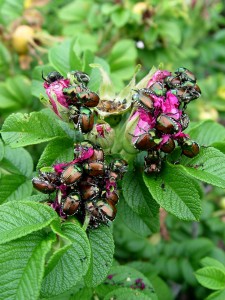Battling Japanese Beetles
June 28th, 2009
Japanese beetles are one of our worst bug problems. They chew leaves and flowers of more than 200 landscape species, then they can kill off our lawns when the larval stage chews roots in fall and spring.
Should I worry?
Japanese beetles look menacing because they swarm, chew leaves to bits and have the audacity to engage in “pile-up mating” in broad daylight on your prized roses.
Beetles hardly ever kill plants, though. They can do severe cosmetic damage for the six weeks they’re out, but most plants push out new growth after the onslaught.
A bigger threat: patchy lawn death from feeding by the larvae (“grubs”).
What most people don’t realize is that Japanese beetle grubs aren’t the only ones that cause lawn damage. We have just as big of a problem with the similar grubs of the northern masked chafer beetle, but that bug in its adult stage comes out after dark and is rarely noticed.
What should I do?
If you’re seeing more damage than you can tolerate from adult beetles, pick them off and drop them in soapy water (or squish them if you’re not squeamish).
Or spray targeted plants with a repellent such as VeggiePharm (mint oil) or neem oil.
Or kill them with an insecticide. Most effective: carbaryl (Sevin), acephate (Orthene), pyrethroids (bifenthrin, cyfluthrin, permethrin), rotenone and the new bacterium Spinosad.
What about those beetle traps?
They work. The problem is if you’re the only one using them, you’ll lure beetles from hundreds of yards away. And they’ll snack on your plants on the way into the trap. Some won’t go into the trap at all, meaning they’ll continue to snack on your plants as they mate.
Traps are most helpful when someone else lures beetles away from you (especially if all the neighbors have traps but you don’t).
How do I keep beetle grubs from killing my lawn?
Japanese beetles, masked chafer beetles and a few others lay eggs that hatch into grass-root-eating grubs in August. Grubs look like fat, white caterpillars curled into a C-shape. Lawn browns and pulls up like carpet when grubs eat the roots out from underneath. You might also see crows and skunks digging into the turf in search of a grubby meal.
A Japanese-beetle-specific disease called milky spore (available at garden centers) has had uneven results but is long-acting and harmless to pets and people. Drawbacks: It takes 3 years to become fully effective and doesn’t work against non-Japanese beetles.
The mainstream treatment is applying granular imidacloprid (Merit) or halofenozide (Mach 2) to the lawn as a preventive between mid-June and mid-July. These don’t kill the flying adults – they target the ensuing grubs. These work very well as preventives but not so well in the fall.
If you notice grub damage in September and October, your best bet is to either remove and/or smash the grubs you find underneath the death turf or to use a quicker-acting “rescue” insecticide containing trichlorfon (Dylox) or carbaryl (Sevin). It may take 5 to 10 days for these chemicals to work. Once grubs are smashed or poisoned, replant grass. Simply replanting grass without getting rid of the grubs probably will result in the new grass being eaten.
Another organic option is buying living microscopic grub-attackers called “nematodes” (www.GardensAlive.com or www.buglogical.com if you can’t find them locally.) These live organisms need to go down in early fall when the soil temperature is still above 70 degrees. The most effective type is Heterorhabditis bacteriophora.
To see if action is even warranted, dig up a few square-foot test patches of lawn in late August and look for grubs in the root zone. Don’t sweat a few. More than 5 per square foot starts to be trouble, and more than 10 per square foot generally means dead patches by early fall.
Long-Range Beetle Discouragers
To lessen the odds of grub problems in the long term, consider these:
1.) Cut the lawn high. Beetles prefer laying eggs in short turfgrass. Mow 3½ to 4 inches tall.
2.) Don’t irrigate. Beetle eggs hatch best in damp soil. I’d rather have brown grass in summer that bounces back in fall than green grass all summer that gets eaten to death in fall.
3.) Plant more trees. Beetles like to lay eggs in sunny spots. If your yard becomes shadier, the grubs will end up in your neighbor’s sunny front yard.








